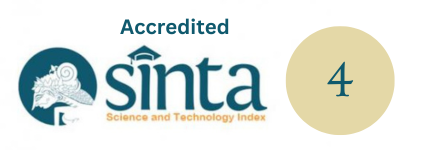Pucuk Bang, A Balinese Musical Composition | Pucuk Bang, Sebuah Komposisi Karawitan Bali
DOI:
https://doi.org/10.59997/jurnalsenikarawitan.v1i3.370Keywords:
Pucuk bang, Tabuh kreasi, gong kebyarAbstract
Bang bang flowers are still needed for religious ceremonies. As long as Hinduism is still firmly established in Bali, the bud flower will still be needed. Not only fulfilling the need for ceremonial facilities, shoots also have a special value, which we should protect and preserve their existence. Pucuk bang is the title of this creative percussion work, which uses the media to express gamelan gong kebyar. This work was inspired by seeing shoots of bang flower plants in the yard of the house. From the etymological meaning of the bud flower, this shoot was created. The method used in this work is the method proposed by Alma M. Hawkins, in the creation of dance, namely the Assessment Stage (exploration), Experiment Stage (improvisation), and Forming Stage. The concept of this work is guided by the Tri Angga concept (kawitan, pengwak, pengcet) and still uses traditional patterns. These traditional patterns were developed from the structure of the song, the technique of the game/game motif with the arrangement of musical elements such as: tone, melody, rhythm, tempo, harmony and dynamics. This creative percussion entitled shoot bang has a duration of 11 minutes and 12 seconds using 28 supporters including the stylist. This percussion creation by shoot bang was presented in a concert, which was recorded at Green Kubu, Br. Sebunibus, Nusa Penida.Downloads
References
Arya Sugiartha. (2012). Kreatifitas Musik Bali Garapan Baru Perspektif Cultural Studies. UPT Penerbitan ISI Denpasar.
Danika, I. P., Santosa, H., & Sudirga, I. K. (2020). Permainan Kendang Bali. Dewaruci, 15(2), 90–100. https://doi.org/10.33153/dewaruci.v15i2.2991
Gede Risa Sutra Gita, I. K. S. (2021). Introduction to the Musical Composition “Tirtha Nadi” | Pengantar Karya Komposisi Karawitan “Tirtha Nadi.” GHURNITA: Jurnal Seni Karawitan, 01(02), 75–83. https://doi.org/10.25124/ghurnita.v1i1.151
I Made Bayu Puser Bhumi, & Hendra Santosa. (2019). Pelatihan Gender Wayang Pada Generasi Muda Bali Untuk Melawan Dampak Negatif Kemajuan Teknologi. KALANGWAN Jurnal Seni Pertunjukan, 5(2), 99–105.
I Putu Prwwangsa Nagara, I. N. S. (2021). Gamelan Gender Wayang Composition “Sandaran Laju” | Komposisi Gamelan Gender Wayang “Sandaran Laju.” GHURNITA: Jurnal Seni Karawitan, 01(02), 117–125. https://doi.org/10.25124/ghurnita.v1i1.333
Made Putra Adnyana, I Gede Yudarta, H. S. (2019). Patra Dalung, Sebuah Komposisi Karawitan Bali Yang Lahir Dari Fenomena Sosial Di Desa Dalung. Kalangwan: Jurnal Seni Pertunjukan, 5(1), 61–67. https://jurnal.isi-dps.ac.id/index.php/kalangwan/article/view/670
Raka, A. A. G. (2013). Menguak Nilai Kearifan Lokal Bunga Pucuk Bang dan Buah Manggis. Udayana University Press.
Santosa, H. S. (2016). Gamelan Sistem Sepuluh Nada dalam Satu Gembyang untuk Olah Kreativitas Karawitan Bali. Pantun, 1(2), 85–96. https://jurnal.isbi.ac.id/index.php/pantun/article/view/747
Sukarta, A. G. (2021). Music Composition Bebarongan “Cepuk”| Tabuh Petegak Bebarongan “Cepuk.” GHURNITA: Jurnal Seni Karawitan, 1(1), 29–36.
Sukerta, P. M. (2010). Tetabuhan Bali I. ISI Press Surakarta.
Supriyadnyana, P. G. W., Mustika, P. G., & Muryana, K. (2020). Pengantar Karya Komposisi Tabuh Kreasi Pepanggulan Amande. Kalangwan: Jurnal Seni Pertunjukan, 6(1), 16–25.
Suryatini, I. W. S. N. K. (2013). Proses Pembelajaran Gamelan Gender Wayang Bagi Mahasiswa Asing di ISI Denpasar.
Yudha, I. N., Widiantara, P., Santosa, H., & Suartaya, K. (2020). Proses Penciptaan Komposisi Karawitan Kreasi Baru Paras Paros. 8(April), 1–13. http://journal.isi.ac.id/index.php/promusika/article/view/3607/2095








